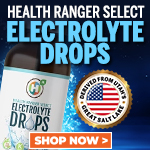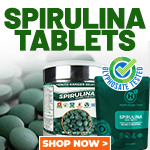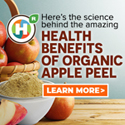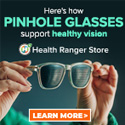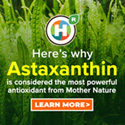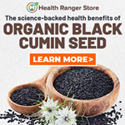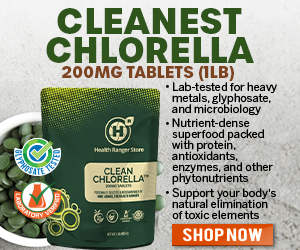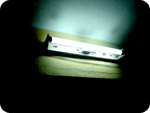
Fluorescent lights release toxic mercury directly into the environment
 Monday, February 11, 2008 Monday, February 11, 2008by Mike Adams, the Health Ranger Editor of NaturalNews.com (See all articles...) Tags: fluorescent lights, health news, Natural News |
- The hidden war above: Chemtrails, HAARP and the battle for planetary control
- CLOT SHOT PLANDEMIC UNFOLDING: Fibrous, rubbery clots caused by covid injections have prion-like seeding activity
- Widespread social and economic unrest: Steve Quayle issues urgent financial warning of imminent asset collapse in new interview with Mike Adams
- DEATH by VACCINE or face PRISON time: Canadian Freedom Convoy leaders CONVICTED for protesting forced vaccination during the Covid Plandemic
- Hidden toll: Federal secrecy shields wind industry's eagle deaths to protect land-hungry turbines that yield minimal power
- Aerosolized bioweapons? Strange “diploid biomasses” falling out of the sky in Florida captured under the microscope
- 7 Must-have multi-functional survival tools for every prepper
- Florida Senate passes bill banning geoengineering and weather modification and Governor DeSantis has indicated it will become law
- Analysis: The coming economic collapse, a mass uprising and Trump's three secret weapons to halt the growing revolt
- Idaho Gov. Brad Little vetoes Medical Freedom Act
- FBI imposed gag order on agents to silence Hunter Biden laptop truth before 2020 election, new chat logs reveal
- Global pedophile ring “Kidflix” shut down in landmark Europol operation
- “Project Aldrin”: Senate probes Meta's alleged censorship dealings with China
- Top German general admits that CONSCRIPTION is “absolutely” necessary to combat Russia
- U.S. Military EXITS fake “Climate Change” hoax after a DECADE of wasting time, money, manpower and resources
- How to detox from metals falling out of the sky
- Mike Adams releases country western hit single: Goin’ Back in Time is Comin’ Home
- Defunding DEADLY mRNA jabs: Government funding for mRNA technology being scrutinized and sidelined until proven "safe and effective" for real
- Newly released JFK files reveal Pentagon's role in creating Lyme disease and covid in the same lab
- European Court of Justice: Healthcare professionals who promoted or administered COVID-19 vaccines are CRIMINALLY LIABLE for any harm caused
- Aerosolized bioweapons? Strange “diploid biomasses” falling out of the sky in Florida captured under the microscope
- Oncologist warns of ‘terrifyingly aggressive’ cancers in children, linked to immune suppression from COVID vaccines
- Britain’s descent into police state censorship: Parents raided for questioning their daughter’s school system online
- Analysis: The coming economic collapse, a mass uprising and Trump's three secret weapons to halt the growing revolt
- Utah governor allows ban on LGBT pride flags in public buildings and schools, will take effect without his signature
- Kiss Your Genetic Privacy Good-Bye! 23andMe Gets Green Light to Sell Your Intimate Genetic Details to Anyone They Want
- FBI imposed gag order on agents to silence Hunter Biden laptop truth before 2020 election, new chat logs reveal
- The Health Ranger releases “Vaccine Zombie” song and music video, using AI-animated zombies for the music video
- DARPA: The shadowy innovator behind the world’s most advanced military technologies
- Mike Adams releases country western hit single: Goin’ Back in Time is Comin’ Home
- “Project Aldrin”: Senate probes Meta's alleged censorship dealings with China
- When antibiotics are unavailable, natural ANTIMICROBIAL compounds become essential first line defenses against infection
- AI-powered forecasting model proves more accurate than traditional systems at predicting the weather
- German researchers find link between mRNA vaccines and GENETIC CHANGES that precede CANCER and AUTOIMMUNE DISORDERS
- Dr. Mary Talley Bowden drops bombshells about children being permanently damaged by mRNA jabs during Tucker Carlson interview
- Ancient kitchen secrets REVEALED: How garlic, ginger and green onions fight cancer and heart disease
- Newly released JFK files reveal Pentagon's role in creating Lyme disease and covid in the same lab
- California's social media censorship law struck down: A victory for free speech or a threat to online safety?
- The Health Ranger releases “Vaccine Zombie” song and music video, using AI-animated zombies for the music video
- Dr. Mike Yeadon releases 15-minute testimony - WATCH - about genocidal intent of COVID “vaccines”
- EPA advisor admits the agency is funneling billions to climate groups ahead of Trump’s return to White House
- Rep. Nancy Mace introduces bill to ban biological males from female facilities on federal property
- Florida takes a stand: DeSantis proposes permanent ban on mRNA vaccine mandates
- Sugarcane extract superior to cholesterol-lowering drugs?
- Survival 101: Effective EMF blocking techniques
- Mike Adams releases country western hit single: Goin’ Back in Time is Comin’ Home
- OpenAI whistleblower who dissented against how the company trained ChatGPT found dead
- Attorney and TikTok influencer explains how he was offered hundreds of dollars to make false claims about Trump, Republicans
- CONSERVATIVES SOUND THE ALARM: Big Pharma and the Left trying to force $32 billion money grab from America’s seniors into year-end spending deal
- Pilots report mysterious lights 'moving at extreme speeds' across Oregon skies
- Trump expected to choose Kelly Loeffler as his agriculture secretary even though she was caught INSIDER TRADING during COVID
- Marketing director responsible for WOKE Jaguar rebrand is also an LGBT activist who supports Black Lives Matter
- Unpacking the Lies That We’ve Been Fed – new song and music video released by Mike Adams, the Health Ranger
- Poll: Majority of Ukrainians want peace negotiations to end war with Russia
- Red Cross issues warning to stop blood plasma donations from vaccinated people
- Scientists confirm: GENIUS brain function can be spontaneously unleashed in humans without any apparent cause
- EPA advisor admits the agency is funneling billions to climate groups ahead of Trump’s return to White House
- HYSSOP: What research reveals about the health benefits of this ancient holy herb
- Two containers with completed ballots fall out of truck in Florida
- Fully vaccinated about to see “tsunami” of illness and death, warns virologist
- Global leaders unite to clamp down on “misinformation” with UN-backed Cascais Declaration
- BREAKING: 2025 NDAA authorizes mandatory military draft of WOMEN across America… as Pentagon pursues global NUCLEAR war with both Russia and China at the same time
- Newly released JFK files reveal Pentagon's role in creating Lyme disease and covid in the same lab
- Michael Yon warns of a ZIONIST TAKEOVER in Trump’s second administration
- BOMBSHELL: DNA testing kits are a SCAM to develop ethnic-specific bioweapons
- Ozempic and Wegovy weight loss drugs are injectable LIZARD VENOM PEPTIDES that may unleash a devastating wave of organ failure… side effects align with symptoms of SNAKE BITES
- The Health Ranger releases “Vaccine Zombie” song and music video, using AI-animated zombies for the music video
- Israeli soldiers accused of even more torture and abuse in the West Bank
- These 13 countries just signed an agreement to engineer a global FAMINE by destroying food supply
- NASA admits that climate change occurs because of changes in Earth’s solar orbit, and NOT because of SUVs and fossil fuels
- RFK Jr. clears key hurdle: Sen. Susan Collins backs controversial HHS nominee, signaling a new era for health policy
- Sermon 30: How Jesus reveals Caesar’s FAKE CURRENCY and FALSE AUTHORITY
According to the Environmental Protection Agency (EPA), approximately 800 million fluorescent lamps are disposed of every year. It only takes a single gram of mercury to contaminate a two-acre pond and cause potential ecological damage through water pollution. Therefore, 800 million lamps produce enough mercury to contaminate about 20 million acres of water.
When the bulbs break, mercury can contaminate the environment, including soils, people and animals in the surrounding the area. Mercury is a potent neurotoxin that can severely harm the human nervous system through either ingestion, inhalation or skin absorption. It is a highly toxic heavy metal that acts as a cumulative poison similar to lead or DDT. Exposure presents the greatest hazard for infants, children and pregnant mothers. Physical symptoms may include an inability to coordinate body movement, an impairment of hearing, vision and speech, skin rashes and kidney damage.
When the bulbs are recycled, a special hazardous waste company generally carries out the process of collecting the unbroken bulbs, crushing them and capturing both the remaining mercury gas and the spent mercury solids. These companies then ship the mercury-bearing waste, using an EPA-permitted hazardous waste transporter, to an EPA-approved hazardous waste treatment, storage and disposal facility.
But most compact fluorescent lights simply end up in landfill and are not recycled at all. That's because most consumers simply throw them in the trash rather than recycling them.
Changes are being made slowly to lower the amount of mercury we may be potentially exposed to. Low energy light bulbs called compact fluorescent lamps (CFLs) contain 4-15mg of mercury compared to normal fluorescent lights, which contain approximately 20 mg of the toxic metal.
"The compact fluorescent light bulb is a product people can use to positively influence the environment to…prevent mercury emissions as well as greenhouse gas emissions. And it's something that we can do now -- and it's extremely important that we do it," said Wendy Reed, the manager of the EPA's Energy Star program. "And the positive message is, if you recycle them, if you dispose of them properly, then they're doing a world of good." The trouble is, of course, that the vast majority of consumers don't recycle them or dispose of them properly, and so fluorescent lights have become a significant source of mercury pollution.
Regulations regarding fluorescent lights
All fluorescent light bulbs are supposed to be disposed of properly, which means recycling these products instead of throwing them in the trash. But these rules are never enforced. There isn't a single recorded case of a person being arrested or fined for throwing a fluorescent light bulb in the trash.Ultimately, it becomes the responsibility of the consumer to find certified waste recycling centers or utilize special hazardous waste collection days in order to dispose of broken or dead fluorescent bulbs. The bulbs cannot be incinerated because they could become much more dangerous if the mercury becomes distributed through the air in smoke that may be inhaled. Most consumers, unfortunately, have no idea that such bulbs are supposed to be disposed of through "hazardous waste collection days" or certified waste recycling centers. Have you ever heard of these? Do you have any idea about where such centers might be in your community? If you don't, you're not alone: Nobody does!
And what about the potential dangers that exist in the transporting of broken fluorescent light bulbs to these recycling centers? Imagine bulbs breaking against one another and mercury vapor escaping into the small space inside a car. Anyone inside the car will potentially be inhaling mercury vapor. Until it's made convenient to the consumer, the consistent recycling of fluorescent lighting by our citizens is little more than a pipe dream -- wishful thinking on the part of the EPA and fluorescent light manufacturers who really don't want to take responsibility for all the mercury they're putting into the environment.
"I share your frustration that there isn't a national infrastructure for the proper recycling of this product," says Reed. "EPA is actively engaged with trying to find a solution that works for these retailers around recycling the product, because it's really, really important. ...The only retailer I know of that is recycling is IKEA. We are working with Wal-Mart on it; we are making some progress. But no commitments have been made on the part of Wal-Mart."
Compact fluorescents contain mercury, too
As an alternative to normal fluorescent lighting, compact fluorescent light bulbs have gained much popularity over the past couple years because they contain less mercury than standard fluorescent lighting. However, it is impossible to have fluorescent lighting without mercury, according to industry engineers. Obviously, recycling is not going to be enough. A mercury-free alternative must be found.According to John Skinner, executive director of the Solid Waste Association of North America: "The problem with the bulbs is that they'll break before they get to the landfill. They'll break in containers, or they'll break in a dumpster or they'll break in the trucks. Workers may be exposed to very high levels of mercury when that happens."
Fluorescent light bulbs are considered universal waste and as such, are subject to the Universal Waste Rule of 2000, a U.S. environmental law that encourages the recycling of mercury-containing materials by allowing products such as fluorescent bulbs to be exempt from certain hazardous waste requirements.
Norway, Sweden, Finland and Denmark have stated they intend to eventually eliminate mercury use completely, and plan on researching alternatives to fluorescent lighting such as LED technology. General Electric has been manufacturing compact and regular fluorescent lights for over 20 years, but now admits that the accumulation of mercury could pose a problem for the environment and human health.
"Given what we anticipate to be the significant increase in the use of these products, we are now beginning to look at, and shortly we'll be discussing with legislators, possibly a national solution here," said Earl Jones, a senior counsel for General Electric.
The solution, of course is LED lights, which contain no mercury and are significantly more energy efficient than both incandescent lights and fluorescent lights. That's why I launched a new company earlier this year, EcoLEDs.com (www.EcoLEDs.com), which provides mercury-free LED lights to businesses and consumers. Right now, LED lights are very expensive to purchase up front, but they pay for themselves in about two years thanks to the savings in electricity (and they keep on working for 50,000 hours...).
There's no doubt that LED lights are the future of lighting, and the sooner we all switch to LED lights, the more quickly we'll stop poisoning our homes, communities and nations with the unsafe disposal of mercury from fluorescent lights.
Spread the word: Fluorescent lights are toxic to life on planet earth. If you care about the health of your family and your planet, don't buy light bulbs made with mercury.
Fluorescent lights at FETCH.news
Get independent news alerts on natural cures, food lab tests, cannabis medicine, science, robotics, drones, privacy and more.
 About the author:Mike Adams (aka the "Health Ranger") is a best selling author (#1 best selling science book on Amazon.com) and a globally recognized scientific researcher in clean foods. He serves as the founding editor of NaturalNews.com and the lab science director of an internationally accredited (ISO 17025) analytical laboratory known as CWC Labs. There, he was awarded a Certificate of Excellence for achieving extremely high accuracy in the analysis of toxic elements in unknown water samples using ICP-MS instrumentation. Adams is also highly proficient in running liquid chromatography, ion chromatography and mass spectrometry time-of-flight analytical instrumentation.
About the author:Mike Adams (aka the "Health Ranger") is a best selling author (#1 best selling science book on Amazon.com) and a globally recognized scientific researcher in clean foods. He serves as the founding editor of NaturalNews.com and the lab science director of an internationally accredited (ISO 17025) analytical laboratory known as CWC Labs. There, he was awarded a Certificate of Excellence for achieving extremely high accuracy in the analysis of toxic elements in unknown water samples using ICP-MS instrumentation. Adams is also highly proficient in running liquid chromatography, ion chromatography and mass spectrometry time-of-flight analytical instrumentation.
Adams is a person of color whose ancestors include Africans and Native American Indians. He's also of Native American heritage, which he credits as inspiring his "Health Ranger" passion for protecting life and nature against the destruction caused by chemicals, heavy metals and other forms of pollution.
Adams is the founder and publisher of the open source science journal Natural Science Journal, the author of numerous peer-reviewed science papers published by the journal, and the author of the world's first book that published ICP-MS heavy metals analysis results for foods, dietary supplements, pet food, spices and fast food. The book is entitled Food Forensics and is published by BenBella Books.
In his laboratory research, Adams has made numerous food safety breakthroughs such as revealing rice protein products imported from Asia to be contaminated with toxic heavy metals like lead, cadmium and tungsten. Adams was the first food science researcher to document high levels of tungsten in superfoods. He also discovered over 11 ppm lead in imported mangosteen powder, and led an industry-wide voluntary agreement to limit heavy metals in rice protein products.
In addition to his lab work, Adams is also the (non-paid) executive director of the non-profit Consumer Wellness Center (CWC), an organization that redirects 100% of its donations receipts to grant programs that teach children and women how to grow their own food or vastly improve their nutrition. Through the non-profit CWC, Adams also launched Nutrition Rescue, a program that donates essential vitamins to people in need. Click here to see some of the CWC success stories.
With a background in science and software technology, Adams is the original founder of the email newsletter technology company known as Arial Software. Using his technical experience combined with his love for natural health, Adams developed and deployed the content management system currently driving NaturalNews.com. He also engineered the high-level statistical algorithms that power SCIENCE.naturalnews.com, a massive research resource featuring over 10 million scientific studies.
Adams is well known for his incredibly popular consumer activism video blowing the lid on fake blueberries used throughout the food supply. He has also exposed "strange fibers" found in Chicken McNuggets, fake academic credentials of so-called health "gurus," dangerous "detox" products imported as battery acid and sold for oral consumption, fake acai berry scams, the California raw milk raids, the vaccine research fraud revealed by industry whistleblowers and many other topics.
Adams has also helped defend the rights of home gardeners and protect the medical freedom rights of parents. Adams is widely recognized to have made a remarkable global impact on issues like GMOs, vaccines, nutrition therapies, human consciousness.
In addition to his activism, Adams is an accomplished musician who has released over a dozen popular songs covering a variety of activism topics.
Click here to read a more detailed bio on Mike Adams, the Health Ranger, at HealthRanger.com.
Take Action: Support Natural News by linking to this article from your website
Permalink to this article:
Embed article link: (copy HTML code below):
Reprinting this article:
Non-commercial use OK, cite NaturalNews.com with clickable link.
Follow Natural News on Facebook, Twitter, Google Plus, and Pinterest
Science News & Studies
Medicine News and Information
Food News & Studies
Health News & Studies
Herbs News & Information
Pollution News & Studies
Cancer News & Studies
Climate News & Studies
Survival News & Information
Gear News & Information
News covering technology, stocks, hackers, and more



"Big Tech and mainstream media are constantly trying to silence the independent voices that dare to bring you the truth about toxic food ingredients, dangerous medications and the failed, fraudulent science of the profit-driven medical establishment.
Email is one of the best ways to make sure you stay informed, without the censorship of the tech giants (Google, Apple, Facebook, Twitter, YouTube, etc.). Stay informed and you'll even likely learn information that may help save your own life."
–The Health Ranger, Mike Adams

















